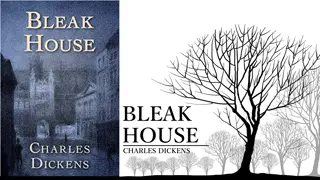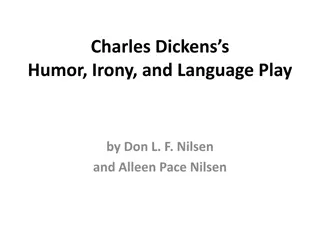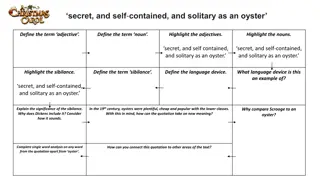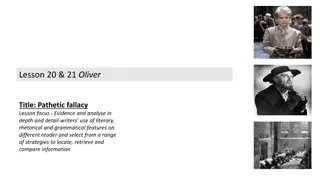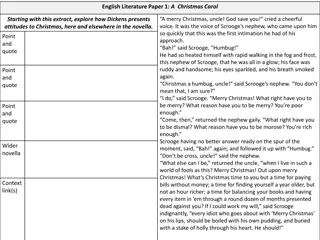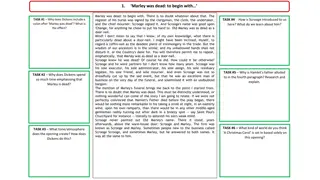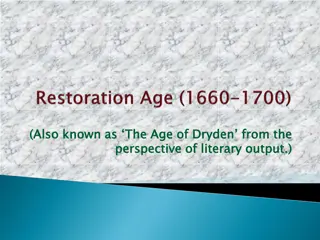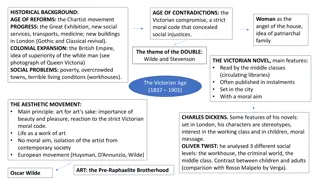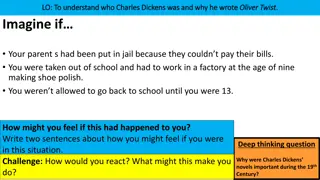Analyzing Literary and Structural Devices in "Hard Times" by Charles Dickens
The use of literary and structural devices in Charles Dickens's "Hard Times," focusing on examples such as metaphors, similes, repetition, and mood to convey deeper meanings and evoke emotions in the reader. Discover how these devices impact the reader's impression and understanding of the text, with a particular emphasis on the bleak and mechanical portrayal of a town's oppressive atmosphere through descriptive analysis.
Download Presentation

Please find below an Image/Link to download the presentation.
The content on the website is provided AS IS for your information and personal use only. It may not be sold, licensed, or shared on other websites without obtaining consent from the author.If you encounter any issues during the download, it is possible that the publisher has removed the file from their server.
You are allowed to download the files provided on this website for personal or commercial use, subject to the condition that they are used lawfully. All files are the property of their respective owners.
The content on the website is provided AS IS for your information and personal use only. It may not be sold, licensed, or shared on other websites without obtaining consent from the author.
E N D
Presentation Transcript
How to Write a Literature Analysis using an example from Hard Times by Charles Dickens. Analyzing Literary and Structural Devices Answer First Language English Question (GCSE/IGCSE)
Literary devices are techniques that authors use to enhance their writing, convey meaning, or evoke emotions. Examples: - Metaphor: Comparing two unlike things without using 'like' or 'as.' What Are Literary Devices? - Simile: Comparing two things using 'like' or 'as.' - Personification: Giving human qualities to inanimate objects. - Imagery: Descriptive language that appeals to the senses.
Structural devices relate to how a text is organized or structured to create a particular effect. Examples: - Syntax: The arrangement of words and phrases to create well-formed sentences. What Are Structural Devices? - Repetition: Repeating words or phrases for emphasis. - Chronological order: Presenting events in the order they occur. - Juxtaposition: Placing contrasting elements side by side to highlight differences.
'It was a town of red brick, or of brick that would have been red if the smoke and ashes had allowed it... the piston of the steam-engine worked monotonously up and down like the head of an elephant in a state of melancholy madness.' Example of Literary Devices in Action Analysis: - Metaphor: 'The piston of the steam- engine worked... like the head of an elephant' This metaphor gives the steam-engine a sense of weight and monotony. - Personification: 'Interminable serpents of smoke' Smoke is described as a snake, poisoning the town.
Text: 'It contained several large streets all very like one another, and many small streets still more like one another...' Analysis: Example of Structural Devices in Action - Repetition: Repeating 'like one another' emphasizes the uniformity and monotony of the town, reflecting the boredom and lack of liveliness in the town. - Long Sentences: The use of long, flowing sentences reflects the unending and monotonous life of the town s inhabitants.
- Mood of Gloom and Oppression: The dark imagery and repetition create a sense of hopelessness and bleakness. Effects of Devices on Reader s Impression - Mechanical Life: The repetitive sentence structure mirrors the repetitive lives of the townspeople, highlighting the lack of individuality and freedom.
- Point: Make a clear point. PEEL Structure: How to Write a PEEL Paragraph - Explanation: Explain how the evidence supports your point. - Evidence: Support your point with evidence. - Link: Connect your point to the question or overall argument.
Question: How does the author use structural and literary devices to express the mood of the town in Hard Times? Example PEEL Paragraph Question
In Hard Times, Dickens uses both literary and structural devices to emphasize the bleak and lifeless atmosphere of the town. The author employs personification and metaphor to describe the town, such as the 'interminable serpents of smoke' that suggest a threatening and overwhelming presence, and the 'piston of the steam-engine' compared to 'the head of an elephant in a state of melancholy madness. Example PEEL Paragraph Answer These images evoke a sense of power and misery in the town. Structurally, Dickens uses repetition in the description of the streets and inhabitants being 'very like one another,' which reflects the monotonous and mechanical lives of the people, making every day indistinguishable from the next. By combining these devices, Dickens creates a vivid, oppressive mood that mirrors the dehumanizing effects of industrialization.
Summary of Key Points - Literary Devices: Metaphor, Personification, Imagery etc. - Structural Devices: Repetition, Long Sentences etc. - PEEL Paragraph: Helps organize analysis in a clear, structured way.



